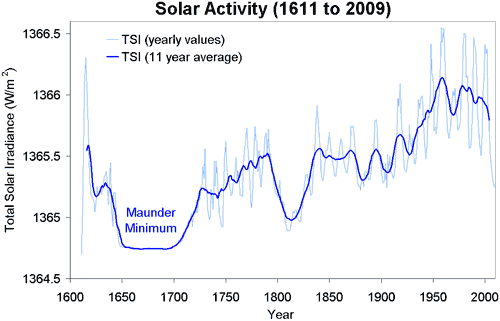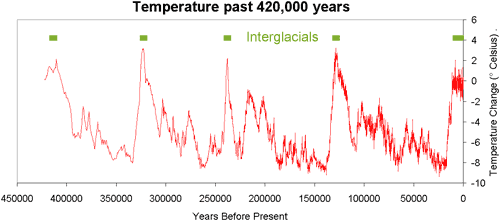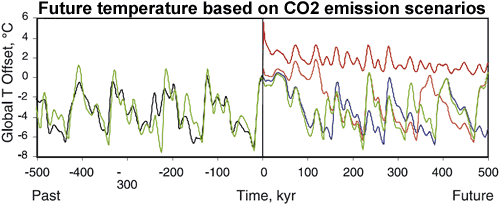The upcoming ice age has been postponed indefinitely
Posted on 27 January 2010 by John Cook
The 9th most popular skeptic argument is that we're heading into an ice age. The whole premise of the website Ice Age Now is that a new ice age could begin any day. Considering the skeptic aversion towards alarmism, it's surprising that this idea has gained so much traction. In the interest of lowering skeptics' stress levels, its time to put all those ice age fears to rest once and for all.
Just a few centuries ago, the planet experienced a mild ice age, quaintly dubbed the Little Ice Age. Part of the Little Ice Age coincided with a period of low solar activity termed the Maunder Minimum (named after astronomer Edward Maunder). It's believed that a combination of lower solar output and high volcanic activity were a major contributor (Free 1999, Crowley 2001), with changes in ocean circulation also having an effect on European temperatures (Mann 2002).

Figure 1: Total Solar Irradiance (TSI). TSI from 1880 to 1978 from Solanki. TSI from 1979 to 2009 from PMOD.
Could we be heading into another Maunder Minimum? Solar activity is currently showing a long term cooling trend. 2009 saw solar output at its lowest level in over a century. However, predicting future solar activity is problematic. The transition from a period of 'grand maxima' (the situation in the latter 20th century) to a 'grand minima' (eg - Maunder Minimum conditions) is a chaotic process and difficult to predict (Usoskin 2007).
Let's say for the sake of argument that the sun does enter another Maunder Minimum over the next century. What effect would this have on Earth's climate? The difference in solar radiative forcing between Maunder Minimum levels and current solar activity is estimated between 0.17 W/m2 (Wang 2005) to 0.23 W/m2 (Krivova 2007). In contrast, the radiative forcing of CO2 since pre-industrial times is 1.66 W/m2 (IPCC AR4), far outstripping solar influence. Add to this the extra CO2 emitted in upcoming decades and other greenhouse gases such as methane. The warming from man-made greenhouse gases far outstrips any potential cooling even if the sun was to return to Maunder Minimum levels.
However, our climate has experienced much more dramatic change than the Little Ice Age. Over the past 400,000 years, the planet has experienced ice age conditions, punctuated every 100,000 years or so by brief warm intervals. These warm periods, called interglacials, typically last around 10,000 years. Our current interglacial began around 11,000 years ago. Could we be on the brink of the end of our interglacial?

Figure 2: Temperature change at Vostok, Antarctica (Barnola 2003). Interglacial periods are marked in green.
How do ice ages begin? Changes in the earth's orbit cause less sunlight (insolation) to fall on the northern hemisphere during summer. Northern ice sheets melt less during summer and gradually grow over thousands of years. This increases the Earth's albedo which amplifies the cooling, spreading the ice sheets further. This process lasts around 10,000 to 20,000 years, bringing the planet into an ice age.
Not all interglacials last the same amount of time. An ice core from Dome C, Antarctica offered a glimpse of temperatures going back 720,000 years. Climatic conditions 420,000 years ago were similar to current conditions. At that time, the interglacial lasted 28,000 years, suggesting our current interglacial may have lasted a similar period without human intervention (Augustin 2004).
The similar conditions between now and 400,000 years ago are due to similar configurations in the Earth's orbit. At both times, the forcing from orbital variations showed much less change then in other interglacials. Simulations with the current orbit find that even without CO2 emissions, the current interglacial is expected to last at least 15,000 years (Berger 2002).
Of course, the question of how long our interglacial lasts without human intervention is moot. We are intervening. So what effect do our CO2 emissions have on any future ice ages? This question is examined in one study that examines the glaciation "trigger" - the required drop in summer northern insolation to begin the process of growing ice sheets (Archer 2005). The more CO2 there is in the atmosphere, the lower insolation needs to drop to trigger glaciation.
Figure 3 examines the climate response to various CO2 emission scenarios. The green line is the natural response without CO2 emissions. Blue represents an anthropogenic release of 300 gigatonnes of carbon - we have already passed this mark. Release of 1000 gigatonnes of carbon (orange line) would prevent an ice age for 130,000 years. If anthropogenic carbon release were 5000 gigatonnes or more, glaciation will be avoided for at least half a million years. As things stand now, the combination of relatively weak orbital forcing and the long atmospheric lifetime of carbon dioxide is likely to generate a longer interglacial period than has been seen in the last 2.6 million years.

Figure 3. Effect of fossil fuel CO2 on the future evolution of global mean temperature. Green represents natural evolution, blue represents the results of anthropogenic release of 300 Gton C, orange is 1000 Gton C, and red is 5000 Gton C (Archer 2005).
So we can rest assured, there is no ice age around the corner. To those with lingering doubts that an ice age might be imminent, turn your eyes towards the northern ice sheets. If they're growing, then yes, the 10,000 year process of glaciation may have begun. However, currently the Arctic permafrost is degrading, Arctic sea ice is melting and the Greenland ice sheet is losing mass at an accelerating rate. These are hardly good conditions for an imminent ice age.
Thanks to John Cross for putting me onto a few very relevant papers while preparing this post.































 Arguments
Arguments






























Coincidentally, the topic of climate sensitivity and the work of Lindzen will be addressed in the next post within a day or two.
Can I recommend that you find the place in the above article where it says "Our current interglacial began around 11,000 years ago. Could we be on the brink of the end of our interglacial?" then continue reading...
However, satellite gravity measurements of the entire Greenland ice sheet find that it's losing ice mass at an accelerating rate - in fact, even faster than the much larger Antarctica.
Close. Firstly, yes, to convert the change in Total Solar Irradiance to radiative forcing, you need to divide by four (the difference between the surface area of a disc which is how Earth absorbs sunlight and the surface area of a sphere). But you also need to remove another 30% of this value to take into account the albedo of the Earth.
So Solar Forcing = ΔTSI * 0.7 * 0.25 = ΔTSI * 0.175
Wang 2005 found the change in TSI since the Maunder Minimum was ~ 1 Wm-2. This translates to a radiative forcing of 0.175 Wm-2. Similarly, Krivova 2007 finds the increase in the solar total irradiance since the Maunder minimum is 1.3 Wm-2 which translates to a radiative forcing of 0.2275 Wm-2.
- 'Climate is always changing and climate scientists ignore this'. I wonder why he ignores the many studies that examine past climate change and calculate climate sensitivity - thus providing evidence for climate's sensitivity to CO2 forcing.
- 'The burp from one volcanic eruption would overpower all the CO2 humans have ever emitted'. The numbers say otherwise as does the CO2 record which shows not a blip during the 20th Century's largest volcanic eruptions.
- 'The amount of CO2 we emit is tiny compared to the amount that stays in the atmosphere'. Considering we emit 29 billion tonnes of CO2 and 15 billion tonnes stays in the atmosphere, I wonder how he works out 29 billion is tiny compared to 15 billion.
Most perplexing for me is that he continues to repeat these falsehoods after his errors have been pointed out to him, with utmost confidence and contempt for, well, nearly every climate scientist in the world. I see him debate Barry Brook live this afternoon in Brisbane so maybe I'll gain more an insight then.How much CO2 will we have to keep emitting to keep glaciation at bay for the next 10k years?
In response to your question about the timing of the next potential glacial phase inception, here's what the AR5, WG1, Chapter 5 has to say about that:
LINK
Further:
SOURCE
Looking beyond that, research has found that the ability to offset the next 5 glacial phase inceptions lies within the purview of humans:
And
SOURCE